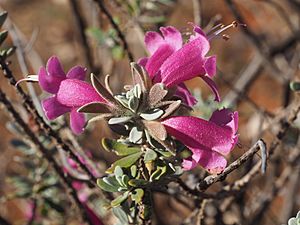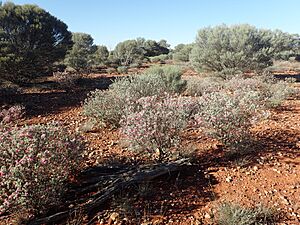Eremophila glandulifera facts for kids
Quick facts for kids Eremophila glandulifera |
|
|---|---|
 |
|
| Eremophila glandulifera leaves and flowers | |
| Scientific classification | |
| Genus: |
Eremophila (plant)
|
| Species: |
glandulifera
|
Eremophila glandulifera is a beautiful flowering plant that grows in Western Australia. It belongs to the figwort family, which is also known as Scrophulariaceae. This plant is special because it's endemic to Western Australia, meaning it naturally grows only there. It's a small bush with soft, grey, hairy leaves and pretty flowers that are usually deep pink or red. You can often find it growing in mulga woodland areas.
Contents
What Does Eremophila glandulifera Look Like?
Eremophila glandulifera is a straight-growing bush. It can reach a height of about 0.3 to 1 meter (1 to 3 feet). Its branches are lumpy and covered in hairs.
Leaves and Flowers
The leaves are usually about 9 to 18 millimeters (0.35 to 0.7 inches) long. They are also 4 to 7 millimeters (0.16 to 0.28 inches) wide. Their shape is like a spear or an egg. They look grey because they are covered in many star-shaped hairs.
The flowers grow one by one where the leaves meet the stem. Each flower sits on a hairy stalk that is usually 2 to 4 millimeters (0.08 to 0.16 inches) long. There are 5 green or purple sepals, which are like small leaves that protect the flower bud. These sepals are about 10 to 15 millimeters (0.39 to 0.59 inches) long and are hairy inside and out.
The petals are 25 to 30 millimeters (0.98 to 1.2 inches) long. They join together at the bottom to form a tube shape. This tube is a deep pink to red color. Inside the top part of the tube and on the lower petal, you can see deep red spots. The tube and its petal parts are hairy on both sides, especially inside the tube. The hairs on the leaves, sepals, and petals often have branches and a tiny gland at their tip. The 4 stamens, which hold the pollen, stick out beyond the end of the flower tube.

When Does It Flower and What About Fruits?
This plant flowers from May to October. After the flowers, it produces fruits. These fruits are woody and have a papery covering. They are about 7 to 8 millimeters (0.28 to 0.31 inches) long.
How Was This Plant Named?
The scientific name for this plant, Eremophila glandulifera, was first officially described in 2007. This was done by a scientist named Robert Chinnock. His description was published in a book about Eremophila plants.
Meaning of the Name
The second part of the plant's name, glandulifera, comes from a Latin word. It means 'bearing glands'. This refers to the special glandular hairs found on this plant.
Where Does Eremophila glandulifera Grow?
You can usually find Eremophila glandulifera growing on stony clay or granite soils. It often grows in mulga woodlands. These areas are located between Kalgoorlie and the road connecting Mullewa to Carnarvon. This covers parts of the Murchison and Yalgoo regions in Western Australia.
Is This Plant Endangered?
The Western Australian Government's Department of Parks and Wildlife has looked at the status of this plant. They have classified Eremophila glandulifera as "not threatened." This means it is not currently at risk of disappearing.
How Is This Plant Used in Gardens?
The flowers of this eremophila plant can be pale pink to bright lipstick pink. This makes it a very attractive bush to have in a garden.
Growing New Plants
It is easier to grow new Eremophila glandulifera plants by grafting them. Grafting means joining a part of this plant onto another plant, like a Myoporum plant. It is harder to grow them from cuttings, which are pieces of the plant stem.
This plant likes a sunny spot in the garden. It can also handle frost, which is when the temperature drops below freezing. It has even been grown successfully in places with high humidity, like Sydney.

